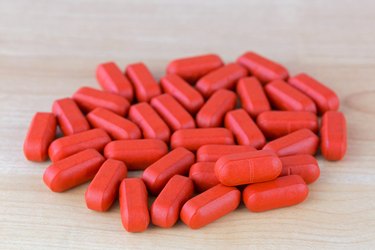
If you're experiencing Nutrilite cherry iron side effects, you might be wondering if they are consistent with other brands of iron. While each brand may vary in the ingredients and fillers they include, comparing the amount of iron in various supplements is a good place to start.
Tip
Iron and folic acid supplements both come with potential side effects such as nausea or headache.
Video of the Day
Iron and Folic Acid
Supplemental iron and folic acid are both commonly prescribed or recommended by doctors or registered dietitians for people who may be deficient or needing additional nutrients, such as during pregnancy. Iron is a mineral that is needed to make hemoglobin, which transfers oxygen from the lungs to the tissues. It also supports muscle metabolism and healthy connective tissues, according to the National Institutes of Health (NIH).
Video of the Day
When the body does not absorb iron, you can become deficient. Most people will experience minimal effects. However, if it progresses to iron deficiency anemia, the Academy of Nutrition and Dietetics says you will experience symptoms including weakness, fatigue, headaches, pale skin and dizziness.
You can get iron from animal sources such as lean beef, chicken and turkey. It's also in plants, but your body does not absorb iron from sources like beans, lentils, tofu, baked potatoes and fortified breakfast cereals as easily as it does from animal sources.
Folate or folic acid is part of the B vitamins. It's most commonly associated with pregnancy since it helps reduce the risk of birth defects. That's why this B-9 vitamin is found in prenatal supplements. For non-pregnant people, folate plays a role in making DNA and other genetic material, and it's required for your cells to divide, according to the NIH.
You can get folate naturally from vegetables, beef liver, fruits and fruit juices, nuts, beans and peas. Folic acid is added to enriched flour, pasta, rice and bread. It's also in fortified breakfast cereals. Unlike iron deficiencies, the NIH says folate deficiency is rare in the United States. The main concern with a lack of folate is in pregnant women.
Side Effects of Iron
Common side effects associated with iron supplements, according to the Mayo Clinic include abdominal or stomach pain, cramping, backache, chest pain, chills, dizziness, fast heartbeat, headache, metallic taste, nausea or vomiting and more.
Nutrilite cherry iron side effects are similar to other supplements with iron. It should be noted that this supplement is not available on the main Amway website. It is only sold by third parties or on the Amway India site. That said, this product contains 15 milligrams of iron from three sources: ferrous bisglycinate, ferrous fumarate and mustard greens. Mustard greens are one of nature's richest plant sources of iron, according to the website.
Some supplements will combine iron and folic acid. Fefol iron tablets side effects are similar to the side effects you may experience when taking iron or folic acid.
The Recommended Daily Allowances (RDA) for adults, aged 19 to 50 years old is 8 milligrams for males and 18 milligrams for females, with pregnant women needing 27 milligrams. The RDA for women goes down to 8 milligrams once they reach age 51, and it stays at 8 milligrams for men.
Taking iron on an empty stomach is the preferred method since it is absorbed better this way. Try to take iron within two hours of finishing a meal. However, if you are experiencing stomach problems, consider taking it with food.
Read more: Types of Iron Supplements
Side Effects of Folic Acid
Taking supplemental folic acid is recommended for women who are wanting to become pregnant, who are pregnant or breastfeeding. Otherwise, the Mayo Clinic says it's best for most people to get their folate from food.
For women who are planning pregnancy or are pregnant, the recommended amount of folic acid from supplements is 400 micrograms per day, according to the Centers for Disease Control and Prevention. This is in addition to the folate in your diet.
If you are taking folate as part of a multivitamin or as a single supplement, it should be in the form of folic acid. While taking folic acid at the recommended levels is considered safe, taking large amounts might hide a vitamin B12 deficiency, according to the NIH. They also mention an increase risk of colorectal cancer, but that is only with very high doses of folic acid.
Some of the more subtle side effects that may happen when taking oral folic acid include nausea, bad taste in your mouth and loss of appetite. You can take folic acid separately or as part of a multivitamin or other supplement. Try to take it at the same time every day so you can get on a schedule.
- The Mayo Clinic: "Folate (Folic Acid)"
- The National Institute of Health: "Iron"
- Academy of Nutrition and Dietetics: "Foods to Fight Iron Deficiency"
- National Institutes of Health: "Folate"
- Centers for Disease Control and Prevention: "Recommendations: Women and Folic Acid"
- The Mayo Clinic: "Iron Supplement"
- Amway India: "NUTRILITE® Cherry Iron"